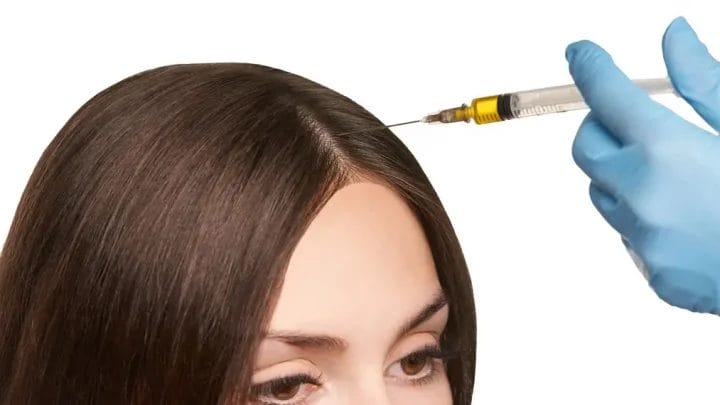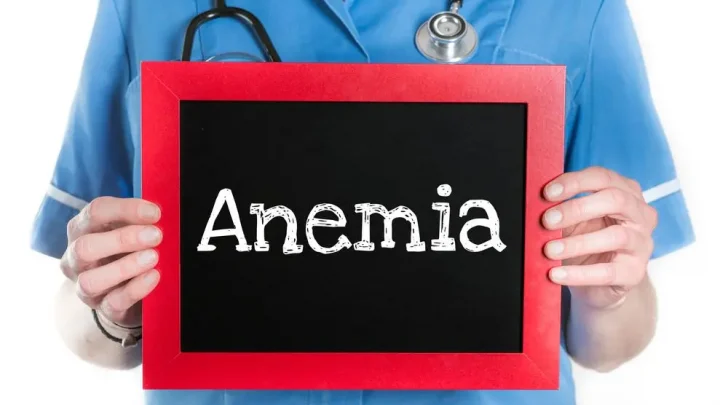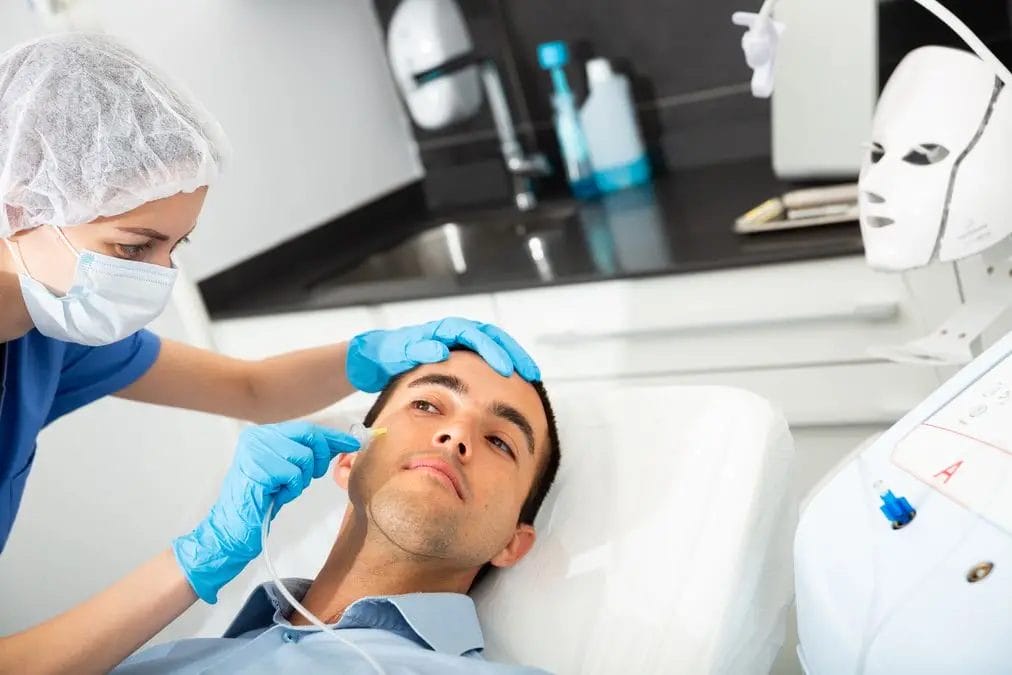
Carboxytherapy of the scalp – is it effective for baldness?
Hair loss treatment is a complicated process consisting of many elements, starting with a proper diet, through proper hair care, up to providing them with dietary supplements supplementing possible lack of nutrients. Vitamin and mineral deficiencies are immediately reflected in the health of not only our hair but also our scalp. Their supplementation is an absolute priority, however, sometimes it turns out that it is not enough to stop hair loss and it becomes necessary to use more invasive methods. One of them is carboxytherapy of the scalp, which consists in introducing individually selected doses of medical carbon dioxide.
Contents
- 1 Baldness, what causes it most often
- 2 Carboxytherapy of the scalp – what is its history?
- 3 Carboxytherapy of the scalp – indications for treatment
- 4 Carboxytherapy of the scalp – the procedure
- 5 Carboxytherapy of the scalp – patient safety and contraindications
- 6 Carboxytherapy of the scalp – opinions about the effects
Baldness, what causes it most often

In normal conditions, in the absence of any disease lesions or other factors that may cause baldness, on average about 150 thousand hairs grow on a man’s head. Hair loss, of course in limited quantities, is completely normal and we lose from 70 to 100 hairs per day e.g. while washing or combing.
The problem starts when more hair falls out, which is sometimes very difficult to control. The first thing to do in such a situation is to immediately identify the causes of this phenomenon, which may be quite numerous. Specialists in diseases of the scalp and hair, such as trichologists with extensive professional experience, indicate the following reasons for the fact that suddenly we begin to bald:
Severe stress and nervous tension states
One of the serious lifestyle diseases plaguing modern society, and the effects of severe nervous tension inherent in stress can be seen almost immediately in thinning hair. They cause deterioration of health to such an extent that the hair is also weakened, becoming more susceptible to falling out.
Other co-morbidities
Accelerated and excessive hair loss may also be a symptom of other ailments, most often endocrinological diseases, and the highest risk concerns people with thyroid diseases, its hyperfunction, hypofunction or Hashimoto disease, which only women suffer from. The risk group also includes patients with cancer, skin diseases such as ringworm, polycystic ovary syndrome, autoimmune diseases and anemia. Intensive and difficult to control hair loss may also be caused by heavy metal poisoning, lead or mercury.
Medication
Depending on their active ingredients they may also have a negative effect on the condition of hair and scalp. There are several groups of drugs, the consumption of which is associated with an increased risk of progressive baldness and these are:
- drugs used in the treatment of cancer, especially during chemotherapy that damages hair follicles and roots;
- anticoagulants, such as heparin;
- medications used in anticonvulsant therapy;
- medications that lower blood lipid levels that are too high;
- immunosuppressants, which prevent rejection of transplants, for example;
- antiepileptic drugs;
- medicines used in cardiovascular diseases, so-called beta-blockers.
Hormonal disorders
Being the cause of androgenic alopecia, seen in men and women, associated with mutation of one of the sex hormones. Under certain conditions, testosterone can be converted to dihydrotestosterone, or DHT for short, by the enzyme 5 alpha reductase.
This newly formed hormone, DHT, adversely affects the hair follicles, initially disrupting their functioning, then causing weakness and shrinkage, and finally even death. If proper treatment is not undertaken, the result is only one, total hair loss, which carbon dioxide therapy can also help to stop.
Improper hair care treatments
The biggest threat to the health and appearance of our hairstyle are the dangerous ingredients in hair shampoos, parabens, silicone and SLS – y. These are strong, negative chemical compounds damaging hair bulbs, damaging the hair structure, increasing sebum secretion and, in extreme cases, causing skin cancer. You should also refrain from tying your hair up tightly with an elastic band and from using hair dryers and flat irons excessively.
A Diet that is Bad for Hair Health
Cabinets that offer carboxytherapy treatments are also visited by patients whose baldness is caused by an improper diet. Their diet is dominated by unhealthy foods, which not only cause growing overweight and obesity, but at the same time are unfavorable for hair and scalp and lack basic nutrients:
- Vitamin A, also known as retinol, which is responsible for the correct formation of hair and skin cells;
- Vitamin B, and its different varieties, such as B5 (pantothenic acid), B7 (biotin), or B12 (cobalamin), strengthen the hair over its entire length, nourish the hair itself and the hair bulbs, and give them resistance to weathering
- vitamin C, ascorbic acid, an antioxidant whose main task is to remove from the body reactive oxygen species, better known as free radicals. It is also responsible for the proper synthesis of collagen, one of the building materials of hair;
- minerals, elements such as zinc, iron and silicon, conditioning the synthesis of collagen and the production of keratin, also included in the composition of our hair, giving them strength, preventing their fragility and brittleness, increasing the assimilability of other nutrients.
Carboxytherapy of the scalp – what is its history?
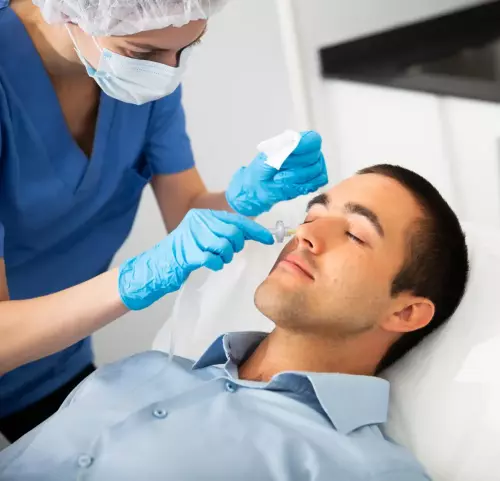
Although in our country this treatment has appeared relatively recently, its history dates back to the thirties ofthe last century, when it was first carried out in France. Initially, it was applied in the treatment of chronic venous insufficiency, e.g. varicose veins of lower limbs and skin atrophy. Innovativeness and effectiveness of such treatments made aesthetic medicine specialists interested in it, using carbon dioxide treatment among others to improve skin firmness or remove shadows under the eyes.
The rapid development and increasing popularity of carboxytherapy occurred in the twenties and today we can still benefit from its numerous advantages, also in the treatment of various types of baldness. This method is based on scientific discoveries of a well-known Danish physiologist Christian Bohr, a phenomenon involving, among others, the expansion of blood vessels, increasing blood flow and oxygen concentration in the treatment area.
Carboxytherapy of the scalp – indications for treatment
As I have already mentioned, it is a procedure with an extremely wide therapeutic use, also to stop hair loss while supporting the growth of new, stronger, thicker and more resistant to damage hair. Carboxytherapy should be carried out in professionally equipped beauty salons and trychological only by people with appropriate training and qualifications. It is increasingly used to treat different types of baldness, not only androgenic, but also telogenic , seborrheic and plaque .
Indications for its performance are:
- loss of large amounts of hair;
- their weakness, fragility and brittleness;
- loss of brightness, visible matting of hair;
- acceleration of new hair growth;
- thickening of too thin hair shaft;
- improvement of scalp health.
Carboxytherapy of the scalp – the procedure
This method of treatment and prevention of baldness is not only effective but also safe, minimally invasive, provided of course it is carried out by the mentioned specialists such as a dermatologist. Unlike mesotherapy of the scalp, no syringe is used here but special devices that inject precisely measured doses of medical carbon dioxideunder the skin.
The method of its injection is selected depending on the purpose of carboxytherapy, it is administered at a different angle, and for each patient the gas temperature, pressure and flow rate are also individually adjusted. Carbon dioxide, carefully purified through a system of efficient filtration, can be applied directly under the skin or into its deeper layers, up to the subcutaneous fatty tissue.
Carboxytherapy of the scalp – patient safety and contraindications
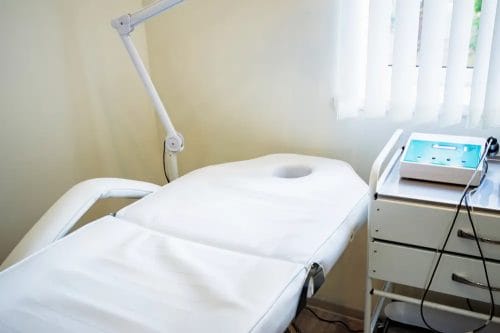
The treatment itself is almost painless, although the sensation of pain depends on the individual sensitivity of the patient. It can be performed regardless of the season, and carbon dioxide, administered in this way, does not pose any threat to health, after all it is a gas naturally occurring in our body. It does not cause side effects or allergic reactions and its excess is removed through lungs and kidneys. For full effects it is recommended to repeat treatments for 4 weeks, every 4 – 7 days, and one treatment lasts from several to several dozen minutes.
After inserting needles small marks, petechiae or bruises may appear on the body but they disappear automatically after a few days after the treatment. It is also possible, although relatively small, risk of larger hematomas and inflammation. However, before you decide to perform such a procedure, it is worth to know the contraindications to its implementation, which is quite a lot, mainly such as:
- diseases of the heart, circulatory and respiratory systems, especially those with a severe course;
- cancerous diseases;
- autoimmune diseases;
- inflammatory conditions, not only of the skin;
- blood clotting disorders;
- kidney failure;
- liver dysfunction;
- epilepsy;
- pregnancy and breast-feeding;
- diabetes, rapid fluctuations in blood glucose levels;
- allergic skin lesions, acne and herpes caused by e.g. the HSV virus;
- impaired healing of wounds;
- uncontrollable arterial hypertension.
Carboxytherapy of the scalp – opinions about the effects
The effectiveness of carboxytherapy in the treatment of alopecia is rated very high, which is also confirmed by the opinions of satisfied patients who praise its following effects:
- inhibition of hair loss, virtually regardless of the type of baldness;
- strengthening and accelerating the regeneration processes of hair bulbs and follicles;
- faster growth of new hair, which grow not only stronger, but also denser;
- Dilation of blood vessels allowing for better oxygenation and nutrition of the scalp, which also promotes hair growth.
Carboxytherapy is used not only to treat baldness, but also to eliminate defects occurring in other parts of the body, including the neck, cleavage or facial skin, acting beneficially on:
- reduction of excess fatty tissue from the abdomen, thighs and buttocks;
- restoring firmness and elasticity of flabby skin
- reduction of cellulite;
- brightening discoloration of the epidermis;
- reduction of swelling and dark circles under the eyes, reducing the appearance of the “tired eyes” effect ;
- reducing the appearance of mimic wrinkles in the corners of the eyes, called“crow’s feet”;
- reduction of the so-called second chin;
- even out and improve skin tone.
RANKING OF TABLETS FOR HAIR LOSS
Sources:


